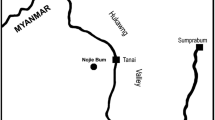Abstract
An Early Cretaceous angiosperm, Sinocarpus decussatus gen. et sp. nov., is described from the Yixian Formation in Liaoning, China, based on an infructescence fragment. It is probably ebracteate, consisting of one terminal fruit and two pairs of pedicellate lateral fruits arranged decussately. Carpels are probably borne on a small convex receptacle. There are no distinct remnants of a perianth although fragments observed at the base of immature fruits may represent perianth parts. No remnants of androecial parts have been observed, and it is unknown whether the flowers were unisexual or bisexual. The basally syncarpous ovary is superior and composed of 3 or 4 carpels. Each carpel contains about 10 anatropous ovules/seeds borne along the linear placentae. Seeds are flattened and embedded in a thick amorphous material. The character combination of Sinocarpus indicates a systematic position among the basal grade of eudicots or the basal core eudicots, and particularly shows similarities to extant Ranunculaceae, Buxaceae, and Myrothamnaceae, but based on the available data the fossil cannot unambiguously be placed in any modern family.
Similar content being viewed by others
Author information
Authors and Affiliations
Corresponding author
Rights and permissions
About this article
Cite this article
Leng, Q., Friis, E. Sinocarpus decussatus gen. et sp. nov., a new angiosperm with basally syncarpous fruits from the Yixian Formation of Northeast China. Plant Syst. Evol. 241, 77–88 (2003). https://doi.org/10.1007/s00606-003-0028-8
Received:
Published:
Issue Date:
DOI: https://doi.org/10.1007/s00606-003-0028-8




